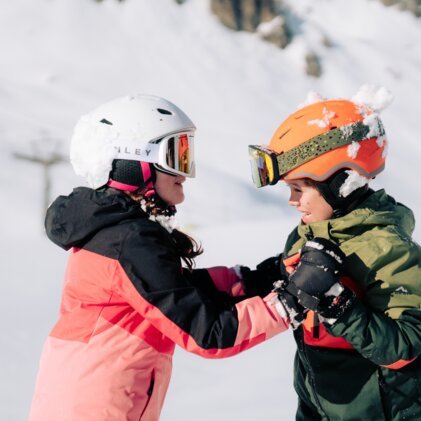
Find the optimal size and the right model
When skiing with children, safety comes first. And the key is: a ski helmet that fits properly. In addition to the right size, easy handling of the adjustment system and fastening as well as a low weight are important. With the right colour and design, the fun on the slopes is doubled.
Ski helmet for kids as an important protective equipment
A children's ski helmet is not just a nice accessory, it is an essential piece of protective equipment. Children are at greater risk of falling than adults, and their heads are more vulnerable to injury. The right helmet in the right size can protect the kids from…
- serious head injuries from falls.
- cold and wind on the slopes.
- UV radiation (especially models with visors).
The decisive factor is: Only a helmet that fits perfectly offers reliable protection in the event of a fall. Use the rental option at INTERSPORT Rent and make sure your kids are always protected when they hit the slopes for your days in the snow. Choose the best equipment for your skiing adventures from our wide range of products.
Fitting and correct sizing of kids’ ski helmets
The most important consideration when choosing a helmet is size. Children's heads change shape and proportions all the time, especially in the first few years of life. To save money, many parents choose to buy a larger helmet and let their child "grow into" it, but this can be dangerous.
How to find the right size of kids ski helmet
When it comes to choosing a ski helmet for your child, safety is the number one priority, and getting the right size is key. A helmet that is too big or too small may not provide the optimal safety your child deserves in an emergency on the slopes.
How to measure the head circumference for the right kids ski helmet
Accurate head circumference measurement is the key to proper helmet fit and maximum protection on the slopes. With this simple method, you can quickly and reliably determine the perfect measurements for your child at home before you start your adventures in the snow.
To find the correct ski helmet for kids, you need:
- A tape measure or alternatively a piece of string and a ruler
- A little patience and a cooperative child
This is how you determine the width of the children's ski helmet:
- Measure the circumference of the head at the thickest part of the head. This is usually the area above the ears and eyebrows (forehead).
- Simply hold the tape measure in place with one hand and place it horizontally around your head.
- Make sure that the measuring tape fits snugly but does not cut into the skin.
- Read off the measured circumference in centimetres and make a note of the result.
- Check the chart below to find the size you need for your child's helmet.
Children's ski helmet: size chart by age
Important note: These values are guidelines only. When in doubt, please refer to the manufacturer's specifications (which may vary) when choosing a helmet.
| Head circumference in cm | Size |
|---|---|
| 40–43 | XXS |
| 44–47 | XS |
| 48–51 | S |
| 52–55 | M |
| 56–59 | L |
| 60–62 | XL |
Tips for fitting a kids’ ski helmet
The helmet should be tight, but not so tight as to be uncomfortable or painful for the child. When you try it on at home before your days in the snow, the closed helmet should not wobble or slide to the side or back. Here are our tips for testing helmets:
- Let your child wiggle his head with the chinstrap open. If the helmet does not slip, it is the best fit.
- To ensure that the helmet protects the entire head, including the forehead, it should sit approximately two finger widths above the eyebrows.
- Cushioned helmets adapt to the shape of the head over time and give way at pressure points. When trying on a helmet, be sure it fits snugly, not loosely.
- Kids often wear a thin hat under their helmet when skiing. Bring your own hat to try on!
Other factors when choosing ski helmets for kids
The best ski helmet for your child should not only be the right proportions but also have other important features. In addition to the right fit, factors such as weight, material, adjustability and age-appropriate features play a critical role in ensuring optimal protection and comfort for your days in the snow.
The weight of children's ski helmets
Size and age are not the only factors to consider when buying a new helmet. The weight of the helmet is also important. Why is that? In the event of a fall, the weight of the helmet puts additional strain on the child's neck muscles. Lighter products should therefore be chosen, especially for toddler ski helmets or younger kids. Modern models weigh between 300 and 500 grams, depending on size and material.
Ski helmet for kids: materials and construction
Most children's helmets are made as an in-mold construction, which makes them particularly light. This is ideal for very small children and beginners. Ski helmets for kids are usually made of:
- An outer hard shell made of ABS plastic for impact protection
- An inner layer of shock-absorbing EPS foam
- Soft padding for comfort and a custom fit
Adjustment and fitting systems for kids’ ski helmets
High-quality ski helmets for children have:
- Rotating wheel system for easy adjustment
- Removable or adjustable pads for fine tuning
- Easy to operate chinstrap buckles that are easy to use even when wearing gloves
These features are especially important because they allow for precise customization and can grow with the child.
Special requirements for toddler ski helmets
For the very youngest (1-3 years), special helmets for toddlers are available that are tailored to the requirements of this age group. The following criteria apply when choosing a ski helmet for small children:
- Lightweight construction protects fragile neck muscles
- Easy to put on and take off as toddlers are often impatient
- Soft, warm ear pads for added comfort and protection from the cold
- Highly intuitive closures that are easy to use even when wearing gloves
Safety standards for kids’ ski helmets
Many children's models are labeled with a safety certification. If you see the number 1077:2007 on the helmet or in the product description, you know the helmet meets the European standard for ski and snowboard helmets.
A distinction is also made between helmet classes A and B. At INTERSPORT Rent, we recommend Class A helmets for children - a full-shell helmet. It covers a wider safety area than Class B. Unlike the so-called half-shell helmet, it covers the ears and temples. We are happy to advise you at an INTERSPORT Rent shop in more than 800 locations worldwide.
Kids ski helmet with goggles or visor?
Many parents ask themselves this question. The decision in favour of a children's helmet with a visor or a classic model with separate ski goggles is a question of personal preference and the area of use in the snow. The following overview provides some guidance:
Advantages of a visor ski helmet for kids
- Wider field of view than traditional ski goggles
- No additional goggle purchase
- Fogs less quickly in varying snow and weather conditions
- Easy to use - no problems with goggles slipping out of place
Disadvantages of a kids’ ski helmet with visor
- Often more sensitive surface than goggles (after removing the protective film)
- Often less UV protection than special sun ski goggles
- Less flexibility in changing light conditions (no option to change goggles)
For younger children and beginners, a kids’ ski helmet with a visor is often the more practical solution, while advanced young skiers may prefer the flexibility of separate goggles for perfect view. Visit our RENTertainers in the shop at more than 800 INTERSPORT Rent stores worldwide - We will be happy to advise you on suitable products.
Ski helmet for kids: Check them regularly
A ski helmet for children is not a purchase for eternity. Check it regularly for cracks, dents or signs of wear. After a hard fall, the helmet should always be replaced, even if there is no visible damage - the protection may already be compromised. Keep in mind that the maximum service life is about 3-5 years, regardless of external conditions.
At INTERSPORT Rent, you can rent suitable ski helmets for your kids every season - So you always have a wide selection of models in the perfect size without having to buy a new one every year. Our experts regularly check all rental helmets for safety and will be happy to advise you personally!
Frequently asked questions about kids’ ski helmets:
At what age does a child need a ski helmet?
As soon as your child starts skiing, they should wear a helmet, whether they are 2 or 12 years old.
In some countries, wearing a ski helmet is even a legal requirement for kids: In Austria and Italy, all children under the age of 15 must wear a helmet, while in Germany there is no legal requirement, but a strong recommendation for all skiers. In France, there is also no helmet law, while in the United States and the United Kingdom, the law varies from state to state and resort to resort.
Regardless of the law, your child's safety should always come first!
Can my child also wear a hat under a ski helmet?
Yes, but make sure it is a very thin, flat model that is specifically designed to be worn under a helmet. Normal, thick winter hats significantly compromise helmet fit and safety.
How do I know if the helmet is too small?
A kids’ ski helmet that is too small when…
- bruises and red spots appear on the forehead or sides.
- the child complains about headaches after being carried.
- visible gaps between helmet and goggles appear.
- the helmet sits higher on the head than when it was purchased.
How much does a good kids’ ski helmet cost?
A good quality children's ski helmet costs between € 40 and € 120, depending on the brand, gear and features. Entry level models with basic safety features cost between € 40 and € 60, while premium models with additional features such as improved ventilation, integrated visors or lightweight materials cost between € 80 and € 120. Remember that price does not necessarily correlate with safety - all helmets sold in the EU must meet the same safety standards. You can also rent ski helmets and accessories for the season from INTERSPORT Rent. An inexpensive alternative to buying, especially for fast growing children.
INTERSPORT Rent Tip
When trying on helmets, focus on the fit first, not the color or the look! Once you have found the right products from a particular brand, it is your turn to look around.
INTERSPORT Rent offers a practical solution for fast growing children: Seasonal rental of children's ski helmets. This way your child has a perfectly fitting gear with excellent view and additional accessories every season, without you having to buy a new one every year. Our experts will be happy to help you choose the best ski helmet for your child right in the shop at more than 800 locations worldwide.





